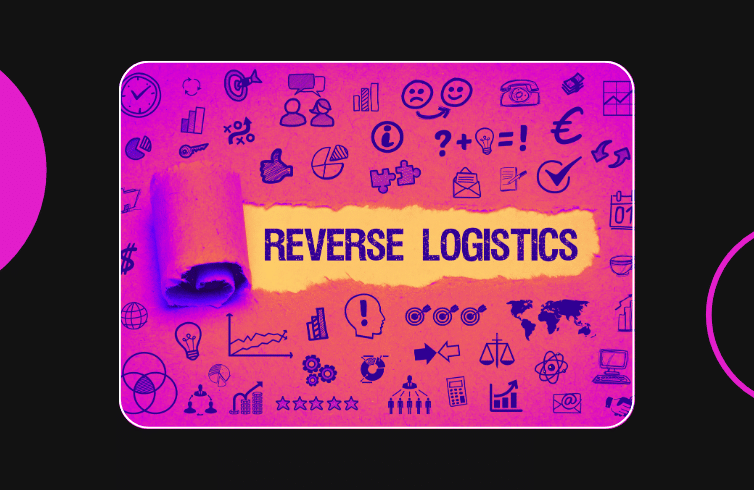How an OMS Can Streamline Your Reverse Logistics Process

Reverse logistics is becoming increasingly complex and costly, yet it remains essential for ensuring customer satisfaction, sustainability, and operational efficiency in modern retail. Better reverse logistics enhances customer experience and loyalty, with fast refunds, fewer touchpoints, and a consistent returns process across channels.
An advanced OMS centralizes and automates return workflows, reducing manual effort, delays, and errors across all fulfillment channels.
Key OMS capabilities include real-time inventory visibility, automated RMA handling, customizable routing, and return analytics, all of which improve return speed and accuracy.
Every retail merchant knows that returns are an inevitable part of the retail business. Yet, when it comes to the reverse logistics process, it quickly becomes apparent that managing returns is often far more complex, costly, and time-consuming than the forward logistics flow, making it an important aspect of the overall supply chain.
In 2022, the cost of retail returns in the U.S. surged to $817 billion, with approximately a quarter of the total attributed to online sales. Out of $1.3 trillion in online retail transactions that year, about 16.5% were ultimately returned. This figure highlights the critical key role the reverse logistics process plays in reducing waste, delivery refusal, and supporting long-term customer retention.
With rising customer expectations, a growing supply chain of digital and physical touchpoints, and pressure to reduce reverse logistics costs, retailers can no longer afford to treat returns as an afterthought.
What was once seen as an operational headache can now be transformed into a genuine competitive advantage, especially when supported by the right technology.
In this article, we’ll review the essentials of the reverse logistics process and show how a modern, centralized order management system (OMS) can help you streamline the key elements involved in reverse logistics.
What is reverse logistics in retail?
Reverse logistics refers to the backward flow of goods through the supply chain, specifically the process by which products move from end customers back to retailers, suppliers, or manufacturers.
It’s the opposite of traditional forward logistics, where goods move from suppliers to retailers and then to the buyers. In practice, reverse logistics focuses on a range of activities—a backward movement of goods across the supply chain that applies to end-of-life goods, electronic equipment, and defective products, including:
- Product returns from customers, especially for merchandise purchased online
- Exchanges and warranty claims for defective or unwanted items
- Restocking unsold inventory that needs to be returned to the warehouse or redistributed
- Managing damaged or defective goods that must be repaired, recycled, or disposed of
- Disposing of or recycling products that have reached the end of their product lifecycle
Reverse logistics has become an increasingly vital component of logistics management in modern retail, particularly for e-commerce businesses, where higher return rates are common due to the nature of online purchasing.
Research shows that 79% of online shoppers expect free return shipping. In today’s retail landscape, an effective reverse logistics process is an integral part of your overall supply chain management strategy. Do it right, and it’ll allow you to recover value from returned goods, optimize asset recovery, reduce waste, and support the shift towards a more sustainable circular economy.
With rising customer expectations for seamless returns and exchanges, embracing a robust reverse logistics system can turn returns into an opportunity for growth and enhanced customer loyalty.
Why reverse logistics can be challenging
Although a strong reverse logistics process is vital for e-commerce businesses, it’s often one of the hardest areas to master. The complexities arise because returns don’t move through the supply chain like standard shipments.
Here are some of the core operational difficulties you may face:
- Lack of standardization: Returns arrive from countless sources—online, in-store drop-offs, third-party marketplaces—often with inconsistent documentation, labeling, or routing. Without a standardized reverse logistics process, this can hinder operational efficiency, proper handling, and complicate merchandise returns, making it harder for your e-commerce businesses to maintain brand image and customer retention.
- Manual processes: Many retailers still track returns using spreadsheets, emails, or fragmented platforms. Manual RMA (Return Merchandise Authorization) tracking increases errors, delays, and hidden costs associated with returns, making it harder to assess the condition and resale potential of returned goods.
- Disconnected systems: Returns data is too often siloed from fulfillment, inventory management, or customer experience platforms. This disconnection means you’d struggle to know when returned items will be available for resale or if they’re fit for the secondary market.
- Inventory uncertainty: Without real-time visibility, you won’t know when or in what condition returned products are and whether they can be added back to available inventory. This lack of precision leads to issues like overstocking, overselling, or missing sales opportunities, all of which can erode profit margins.
- Customer experience risk: Returns are a critical touchpoint for maintaining customer loyalty. A confusing or delayed returns process can frustrate shoppers, overwhelm support teams, and damage long-term trust.
These challenges multiply when you operate across multiple sales channels, stores, and fulfillment centers, making a seamless reverse logistics system an essential part of a successful supply chain process.
How an OMS supports and simplifies reverse logistics
If you’re a retailer managing returns across multiple sales channels, a modern OMS can serve as a central reverse logistics system, delivering structure, automation, and accountability to every step of the returns process.
An OMS acts as a centralized control hub for reverse logistics operations, connecting returns data with customer service, finance, and fulfillment teams. This centralization enables you to transition from a fragmented, error-prone returns process to a seamless and efficient experience.
Automated return initiation and tracking
An OMS centralizes return requests across all your sales channels, automatically issuing RMAs and providing customers with branded, easy-to-follow return instructions. By automating this critical first step, an OMS eliminates manual efforts in managing returns, allowing your customer experience (CX) and logistics management teams to focus on higher-value activities.
Real-time visibility into returned inventory
Once returns are in motion, an OMS delivers the transparency you seek. Tracking returns in transit and updating their status upon inspection provides an accurate view of what’s available for resale, refurbishment, or proper disposal, making it ideal for managing end-of-life goods and reducing waste from returns.
This eliminates the inventory uncertainty that plagues traditional returns, allowing you to make informed decisions about every returned item.
Streamlined workflows across stakeholders
An OMS connects returns data to fulfillment centers, logistics providers, finance, and customer service platforms, making it a key role player in streamlining returns across the supply chain and supporting a lean supply chain approach.
This connectivity enables you to automate routing rules—directing defective goods to the repair department, sending restockable returns back to the warehouse, or routing products nearing the end of their life for recycling or final disposal.
It results in an accelerated returns process that improves operational efficiency, ensures compliance with a solid reverse logistics plan, and delivers faster refunds and exchanges for customers.
Improved reporting and analytics
With a central OMS, returns can become a valuable source of insights. The system surfaces actionable data, identifying common return reasons, spotting recurring product defects, or highlighting customer demand patterns that you can use to modify your offerings and reduce return rates over time.
According to the Reverse Logistics Association, roughly 5.8 billion lbs. of returned merchandise ended up in landfills in the U.S. in 2020 alone, making data-driven logistics management more critical to reducing waste and environmental impact.
Business benefits of a smarter reverse logistics process
When you manage your returns correctly, reverse logistics can become a catalyst for operational efficiency, customer satisfaction, and long-term growth. An advanced OMS simplifies returns and delivers concrete benefits such as:
Reduced operational costs
By automating and standardizing the returns workflow, you can reduce manual effort, minimize errors, and significantly lower costs across your supply chain, making returns a low-cost transaction.
Faster resolution times
An OMS enhances the speed and precision of returns, ensuring refunds, exchanges, or credits are processed quickly. This responsiveness strengthens customer loyalty and improves the overall customer experience.
Better inventory accuracy
Real-time tracking and status updates reduce the risk of misplaced or miscounted items, making it easier for you to determine when returned goods can be added back to available stock.
This level of precision enhances inventory management, reduces instances of over-ordering, and prevents lost sales due to delivery failures.
Enhanced customer satisfaction
When returns are seamless, transparent, and properly managed, shoppers feel more confident and satisfied. Research shows that 92% of online shoppers would shop again with a retailer if the returns process were easy.
Sustainability gains
Considering that approximately 5.8 billion lbs of returned merchandise ended up in landfills in 2020—a number that continues to rise each year—an effective reverse logistics process can help reduce waste by directing returns toward refurbishment, resale in the secondary market, or recycling.
What to look for in an OMS to support reverse logistics
Selecting the right OMS can make all the difference when it comes to streamlining reverse logistics and creating a seamless experience. An effective OMS acts as the central hub that supports returns across multiple sales channels, making returns a manageable and predictable part of the supply chain process.
Here are the key features and considerations you should prioritize:
Centralized return tracking and status management
Look for an OMS that allows you to track every return in one place, providing a single source of truth for status and location across warehouses, stores, and return centers. This ensures returns aren’t lost, delayed, or overlooked, a common issue when relying on manual methods.
Multi-location inventory visibility
Modern retailers operate across multiple stores, warehouses, and sometimes collaborate with logistics providers or third-party logistics (3PL) companies. An effective OMS must provide multi-location inventory visibility across the entire supply chain process, making it easy to locate returned items regardless of their path through the supply chain. This enhances asset recovery, enabling you to make informed decisions about restocking, refurbishment, or proper disposal.
Integration with customer service and ERP systems
An ideal OMS seamlessly integrates with your existing customer service platforms and ERP systems, ensuring returns data is instantly available to support all your teams. This integration enhances communication across various departments, resulting in a seamless customer experience when resolving returns and exchanges.
Customizable workflow
Each return has a unique path; a warranty claim may require inspection and refurbishment, while a simple return might be restocked immediately. An OMS that allows you to configure rules and workflows based on product category, return reason, or destination can save time, reduce errors, and enable a more effective reverse logistics process.
Robust reporting and analysis
An OMS with robust analytics allows you to track return reasons, identify recurring defective products, spot excess inventory hotspots, and understand return patterns. These insights enable you to reduce waste and improve operational efficiency.
Reverse logistics as a growth enabler
With the support of a centralized reverse logistics system, returns can evolve from a cost center to a core area for operational improvement, asset recovery, and customer loyalty.
By streamlining the returns process across multiple sales channels, you can reduce waste, improve inventory management, and protect your profit margins, making returns an opportunity for recovery, sustainability, and long-term growth.
This approach enables you to better utilize returned goods from raw materials to finished products, thereby reducing packaging material waste across your supply chain.
With the right warehouse management software in place, you can transform returns into an efficient, data-driven workflow—one that satisfies customer expectations, improves operational efficiency, and ultimately strengthens your brand’s position in an increasingly competitive market.
Organized reverse logistics can enable the growth of your business, and fabric’s advanced AI-powered OMS can enable a centralized and reliable reverse logistics system for you.
Ready to optimize every part of your fulfillment flow, from purchase to returns? Contact our team for more information or request a demo to experience our reimagined OMS.

Digital content editorial team @ fabric




